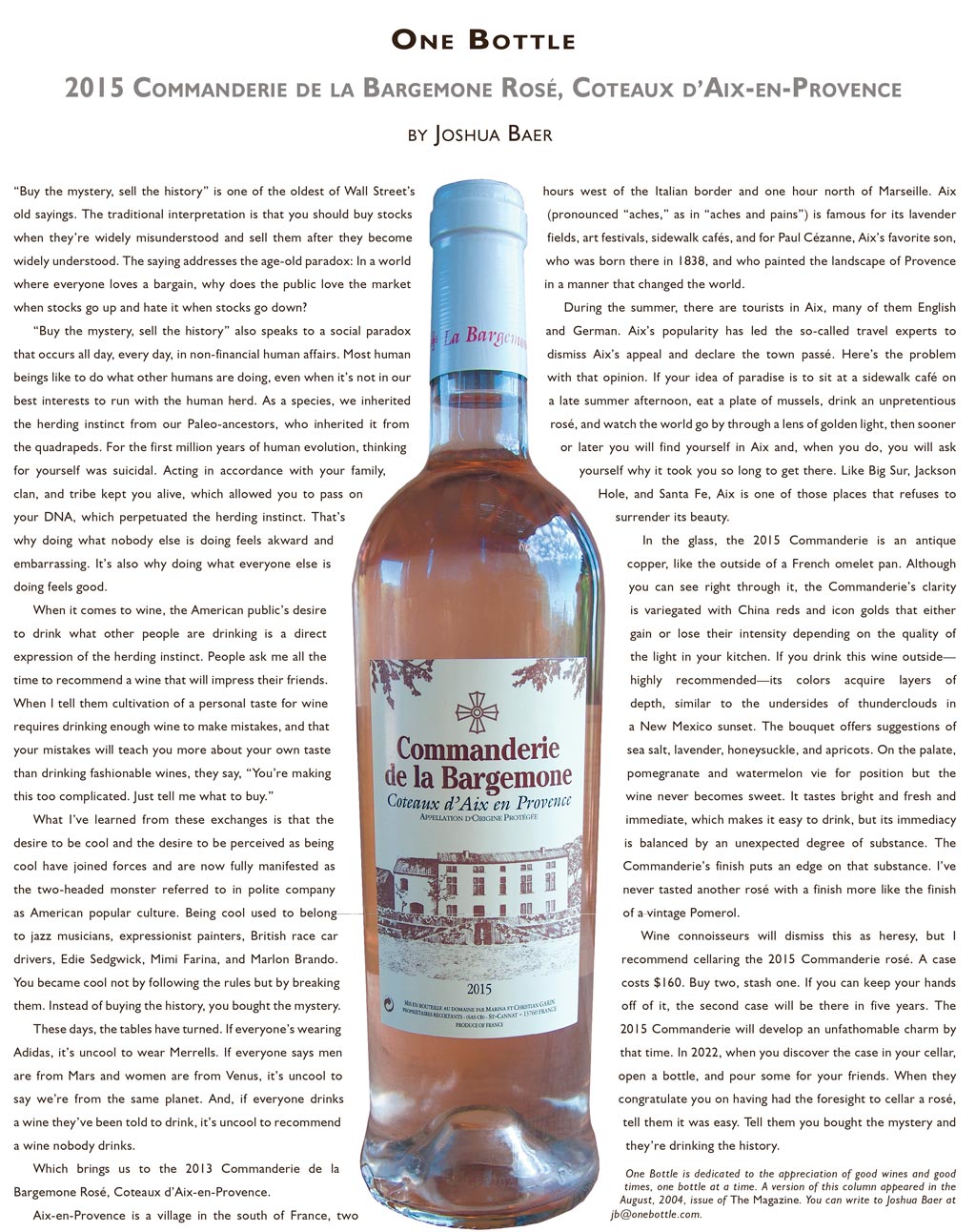2015 Commanderie de la Bargemone Rosé, Coteaux d’Aix-en-Provence
“Buy the mystery, sell the history” is one of the oldest of Wall Street’s old sayings. The traditional interpretation is that you should buy stocks when they’re widely misunderstood and sell them after they become widely understood. The saying addresses the age-old paradox: In a world where everyone loves a bargain, why does the public love the market when stocks go up and hate it when stocks go down?
“Buy the mystery, sell the history” also speaks to a social paradox that occurs all day, every day, in non-financial human affairs. Most human beings like to do what other humans are doing, even when it’s not in our best interests to run with the human herd. As a species, we inherited the herding instinct from our Paleo-ancestors, who inherited it from the quadrapeds. For the first million years of human evolution, thinking for yourself was suicidal. Acting in accordance with your family, clan, and tribe kept you alive, which allowed you to pass on your DNA, which perpetuated the herding instinct. That’s why doing what nobody else is doing feels awkward and embarrassing. It’s also why doing what everyone else is doing feels good.
When it comes to wine, the American public’s desire to drink what other people are drinking is a direct expression of the herding instinct. People ask me all the time to recommend a wine that will impress their friends. When I tell them cultivation of a personal taste for wine requires drinking enough wine to make mistakes, and that your mistakes will teach you more about your own taste than drinking fashionable wines, they say, “You’re making this too complicated. Just tell me what to buy.”
What I’ve learned from these exchanges is that the desire to be cool and the desire to be perceived as being cool have joined forces and are now fully manifested as the two-headed monster referred to in polite company as American popular culture. Being cool used to belong to jazz musicians, expressionist painters, British race car drivers, Edie Sedgwick, Mimi Farina, and Marlon Brando. You became cool not by following the rules but by breaking them. Instead of buying the history, you bought the mystery.
These days, the tables have turned. If everyone’s wearing Adidas, it’s uncool to wear Merrells. If everyone says men are from Mars and women are from Venus, it’s uncool to say we’re from the same planet. And, if everyone drinks a wine they’ve been told to drink, it’s uncool to recommend a wine nobody drinks.
Which brings us to the 2013 Commanderie de la Bargemone Rosé, Coteaux d’Aix-en-Provence.
Aix-en-Provence is a village in the south of France, two hours west of the Italian border and one hour north of Marseille. Aix (pronounced “aches,” as in “aches and pains”) is famous for its lavender fields, art festivals, sidewalk cafés, and for Paul Cézanne, Aix’s favorite son, who was born there in 1838, and who painted the landscape of Provence in a manner that changed the world.
During the summer, there are tourists in Aix, many of them English and German. Aix’s popularity has led the so-called travel experts to dismiss Aix’s appeal and declare the town passé. Here’s the problem with that opinion. If your idea of paradise is to sit at a sidewalk café on a late summer afternoon, eat a plate of mussels, drink an unpretentious rosé, and watch the world go by through a lens of golden light, then sooner or later you will find yourself in Aix and, when you do, you will ask yourself why it took you so long to get there. Like Big Sur, Jackson Hole, and Santa Fe, Aix is one of those places that refuses to surrender its beauty.
In the glass, the 2015 Commanderie is an antique copper, like the outside of a French omelet pan. Although you can see right through it, the Commanderie’s clarity is variegated with China reds and icon golds that either gain or lose their intensity depending on the quality of the light in your kitchen. If you drink this wine outside—highly recommended—its colors acquire layers of depth, similar to the undersides of thunderclouds in a New Mexico sunset. The bouquet offers suggestions of sea salt, lavender, honeysuckle, and apricots. On the palate, pomegranate and watermelon vie for position but the wine never becomes sweet. It tastes bright and fresh and immediate, which makes it easy to drink, but its immediacy is balanced by an unexpected degree of substance. The Commanderie’s finish puts an edge on that substance. I’ve never tasted another rosé with a finish more like the finish of a vintage Pomerol.
Wine connoisseurs will dismiss this as heresy, but I recommend cellaring the 2015 Commanderie rosé. A case costs $160. Buy two, stash one. If you can keep your hands off of it, the second case will be there in five years. The 2015 Commanderie will develop an unfathomable charm by that time. In 2022, when you discover the case in your cellar, open a bottle, and pour some for your friends. When they congratulate you on having had the foresight to cellar a rosé, tell them it was easy. Tell them you bought the mystery and they’re drinking the history.
One Bottle is dedicated to the appreciation of good wines and good times, one bottle at a time. You can write to Joshua Baer at jb@onebottle.com.
